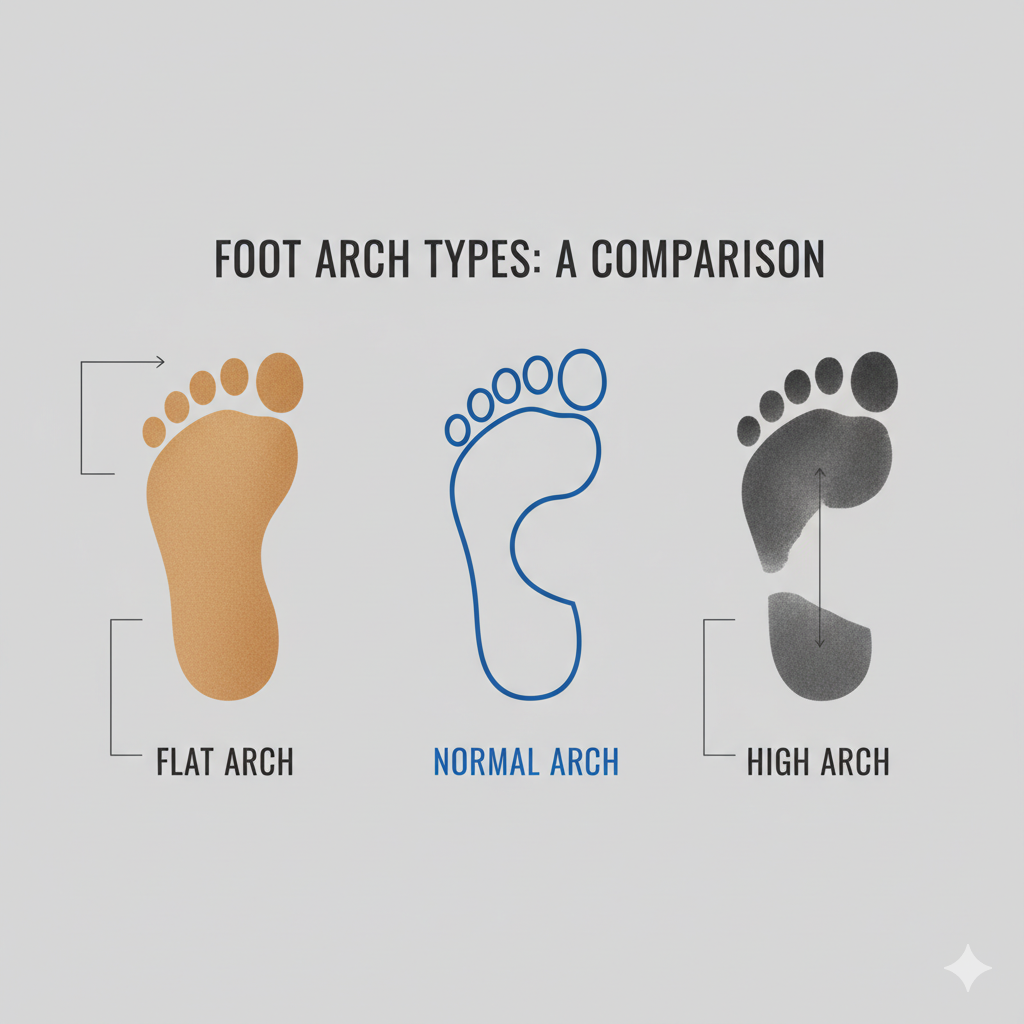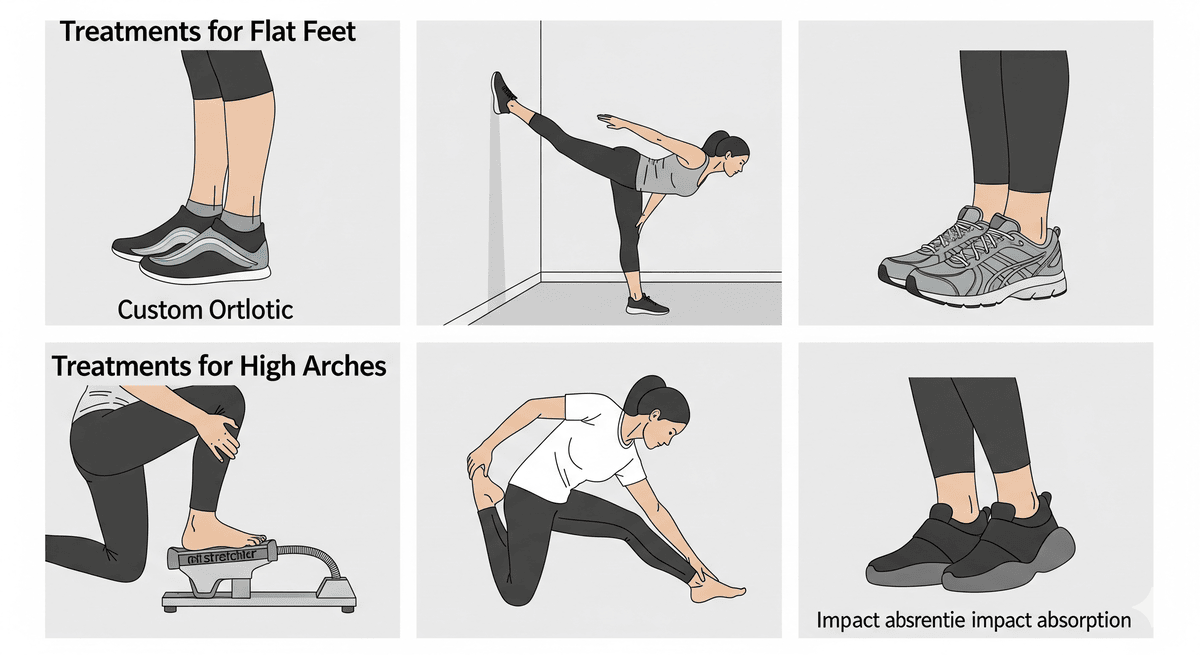Flatfoot and High Arch Deformities
What Are Flatfoot and High Arches?
The arch of your foot is a critical structure designed to absorb shock, distribute your body weight, and adapt to different surfaces as you walk. When the arch is either too low (flatfoot) or too high (high arch), it can disrupt the foot’s mechanics, leading to pain, instability, and a range of secondary problems throughout the body.
These conditions are more than just cosmetic; they are structural deformities that require specialized evaluation. At City Orthopaedics & Sports Medicine, our Foot & Ankle specialist team, including Dr. Jason Hymowitz, are experts in analyzing foot structure and providing treatments that create stability, relieve pain, and improve your overall function.
Understanding Flatfoot (Pes Planus)
A flatfoot is a condition where the arch on the inside of the foot is flattened, allowing the entire sole to touch the floor when standing. This often leads to overpronation, where the ankle rolls inward. While some people have no symptoms, for many, this lack of support can strain muscles and ligaments, causing pain.
Understanding High Arches (Pes Cavus)
A high arch is the opposite condition, where the arch is significantly raised and rigid. This foot type is less flexible and poor at absorbing shock. As a result, excessive pressure is placed on the heel and the ball of the foot, leading to pain, calluses, and a higher risk of other conditions like hammertoes and ankle sprains.

Causes of Flatfoot and High Arches
The underlying cause of your foot structure is often genetic, but other factors can contribute or cause the condition to develop later in life.
- Heredity: The most common cause for both conditions is simply inheriting the foot type from your parents.
- Posterior Tibial Tendon Dysfunction (PTTD): The weakening or tearing of the posterior tibial tendon is a primary cause of adult-acquired flatfoot.
- Injury or Trauma: A fracture or dislocation in the foot can alter its long-term structure.
- Arthritis: Inflammatory conditions like rheumatoid arthritis can cause joints to collapse, leading to a flattened arch.
- Neurological Conditions: High arches, in particular, can sometimes be associated with an underlying neurological condition, making a podiatric evaluation essential.
Symptoms of Structural Foot Deformities
The symptoms are directly related to the mechanical stress each condition creates.
Common Symptoms of Flatfoot:
- Tired, achy feet, especially after standing or activity.
- Pain along the inner side of the ankle (a sign of PTTD).
- Development of bunions and hammertoes.
- Pain in the shins, knees, hips, or lower back due to poor alignment.
Common Symptoms of High Arches:
- Pain in the ball of the foot (metatarsalgia) or the heel (plantar fasciitis).
- Development of hammertoes or claw toes.
- Painful calluses on the ball, side, or heel of the foot.
- Frequent ankle sprains due to instability.
Diagnosing Your Foot Type: A Podiatrist’s Evaluation
A podiatrist can diagnose your foot type and any related problems through a comprehensive evaluation:
- Physical Examination: We will observe your foot’s structure while you are sitting and standing to see how the arch changes with weight-bearing.
- Gait Analysis: Watching you walk is the best way to assess biomechanical issues like overpronation and instability.
- Footwear Evaluation: The wear patterns on your shoes provide valuable clues about how your foot functions.
- X-rays: We use X-rays to get a clear picture of the bone alignment in your feet, which is essential for planning treatment.

Treatment for Flatfoot and High Arches: Creating Stability and Support
Treatment is focused on supporting the foot, improving shock absorption, and relieving pain. While we cannot change your foot type non-surgically, we can make it function pain-free.
Conservative (Non-Surgical) Treatments:
- Custom Orthotics: This is the most important and effective treatment.
- For flat feet, custom orthotics provide support to the arch and control overpronation, reducing strain on tendons and joints.
- For high arches, custom orthotics are designed to provide cushioning and redistribute pressure evenly across the foot, taking the load off the heel and ball.
- Supportive Footwear: We will recommend specific shoe types that offer the right balance of stability (for flat feet) or cushioning (for high arches).
- Bracing: For severe flatfoot with PTTD or unstable high arches, an ankle brace can provide additional support and prevent further injury.
- Physical Therapy: Stretching and strengthening exercises can improve flexibility and strengthen the muscles that support the foot.
Surgical Intervention:
Surgery is reserved for severe cases with debilitating pain that do not respond to conservative care. Our podiatric surgeon can perform complex reconstructive surgery to repair tendons, realign bones, and create a more stable and functional arch.
When faced with pain, injury, or discomfort in your foot or ankle, seeking a timely and precise diagnosis is essential. Dr. Jason Hymowitz, a distinguished board-certified foot and ankle surgeon, offers the expertise and compassionate care you need to move forward with confidence. Renowned for his skill in sports medicine, musculoskeletal deformities, and post-traumatic and cosmetic surgical reconstruction, Dr. Hymowitz blends advanced technology with evidence-based treatment to deliver exceptional outcomes. Whether through conservative care, minimally invasive techniques, or complex reconstructive surgery, he is dedicated to restoring your mobility, relieving your pain, and helping you return to the activities you love. Your path to lasting relief and improved quality of life begins with Dr. Hymowitz — a trusted expert committed to your well-being.


